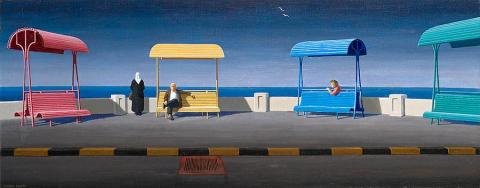THE ESPLANADE, ALEXANDRIA, 1984 - 85
JEFFREY SMART
synthetic polymer paint and oil on board
35.0 x 88.5 cm
signed lower left: JEFFREY SMART
Australian Galleries, Melbourne
Private collection, Queensland
Jeffrey Smart, Australian Galleries, Melbourne, April – May, 1986
Allen, C., Jeffrey Smart Unpublished Paintings 1940 – 2007, Australian Galleries Publishing, Sydney, 2008, p. 189 (illus.)
Jeffrey Smart is an inveterate traveler, stating in an interview with Desmond O'Grady that, 'living in Italy's very convenient for getting around the Mediterranean, as the ancient Romans found.'1 This is reflected in his art, not only in the many paintings of the autostrada, vehicles, and bus and railway stations, but also in the places he visited. During 1984 he went to Bayreuth for the Wagner Festival, followed by Prague, a visit to Australia for an exhibition in Sydney, and then to Cairo and Luxor over Christmas into early January. His paintings of the same time included The Terrace, Madrid Airport II 1984-85, Rome Metro Exit 1984-85 and Off Brindisi 1985. The Esplanade, Alexandria 1984-85 was, no doubt, an outcome of his visit to Egypt. Alexandria, today the second largest city in Egypt, lies directly on the Mediterranean coast. Founded by Alexander the Great circa 331 BC, the Lighthouse of Alexandria was one of the Seven Wonders of the Ancient World, its famed library being the largest. While this would have appealed greatly to Smart, his painting is totally devoid of such fabled references. If anything, it is more like a still life by Giorgio Morandi whom he greatly admired. Figures are set in isolation and nothing moves in an atmosphere of fixed intensity. The barricade in shadow across the foreground acts as a metaphor, keeping the viewer at a distance, the grill a reference to going down the drain. Barry Pearce in his monograph on Smart refers to him shielding 'his emotional life behind a carapace of methodology.'2 Assiduously avoiding personal reference and emotion in his work, Smart involves himself with achieving compositional perfection through the right balance of forms and colours. The images of people in The Esplanade, Alexandria are not so much to do with human beings, as objects to provide the right scale. In another interview some years ago with O'Grady in Rome, Smart said, 'I am getting better at doing my things. Development lies in painting the same themes better rather than seeking new subjects. Giorgio Morandi, one of the greatest modern artists, always painted bottles.'3 In The Esplanade, Alexandria Smart pursues familiar themes with diligent objectivity. All is carefully considered and in perfect balance. The shadows are as precisely delineated as the shelters of which they are part. In the clever use of primary colours, yellow attracts the eye, but the seated figure facing the viewer invites no further investigation. This is repeated in the back view of the women to his right, the profiled figure to his left again a compositional highlight through profiled form and colour. In this classic essay by Smart at his enigmatic best, sensuous colours seduce, suggestions tantalize, but passions are held firmly at bay.
1. Smart, J., in O'Grady, D., Age, Melbourne, 19 October 1984, quoted in Capon, E., et al, Jeffrey Smart retrospective, Art Gallery of New South Wales, Sydney, 1999, p. 57
2. Pearce, B., Jeffrey Smart, The Beagle Press, Sydney, 2005, p. 85
3. Smart, J., quoted in O'Grady, D.,'Agog at Coke crates', Age, Melbourne, 11 March 1978.
DAVID THOMAS
